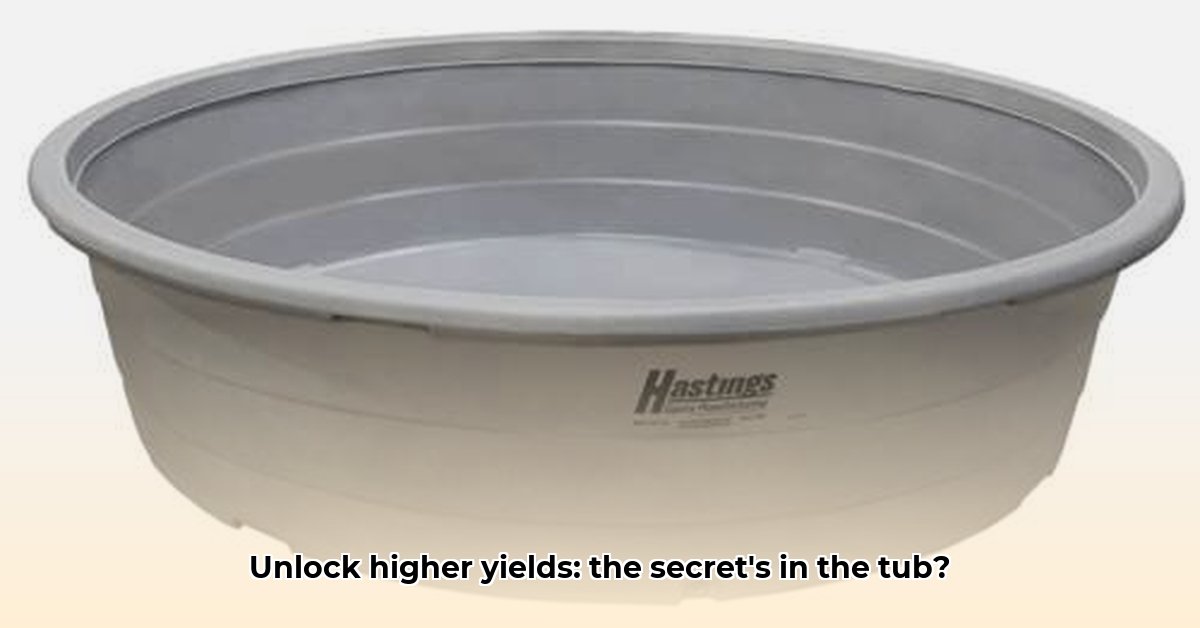
Want a bumper harvest? Reliable water storage is crucial for successful farming, regardless of weather patterns. Galvanized steel water tanks offer a durable and cost-effective solution for ensuring your crops receive consistent irrigation throughout the growing season. This guide provides actionable steps for selecting, installing, and maintaining these tanks for optimal yield and sustainable agricultural practices. For more options, check out these water tank resources.
Choosing the Right Water Tank: Size, Material, and Essential Features
Determining the appropriate tank size is paramount. Underestimating your water needs leads to frequent refills and potential crop stress, while overestimating wastes resources. To calculate the correct size, assess your crop water requirements (considering plant type, farm size, and yield goals), and analyze your region's typical rainfall patterns. Online calculators and local agricultural extension services can assist in this estimation. Remember to account for future expansion.
Why galvanized steel? Its robust construction provides a long lifespan and superior rust resistance compared to other materials such as plastic. "Galvanized steel tanks offer excellent durability and resist corrosion, resulting in a longer service life compared to other materials frequently utilized in agricultural settings," states Dr. Emily Carter, Agricultural Engineering Professor at Cornell University. When purchasing, inspect the tank's construction for quality welds and strong structural integrity. Prioritize tanks with:
- Appropriate Size: Match tank capacity to your calculated water needs, with room for growth.
- Durable Material: Galvanized steel provides optimal rust resistance and longevity.
- Strategic Inlets/Outlets: Conveniently placed inlets and outlets ensure efficient filling and draining. Multiple outlets cater to diverse irrigation needs.
- Reliable Overflow Protection: Prevent spills and water waste with an effective overflow system.
Installing Your Tank: A Step-by-Step Guide
Correct installation is vital for tank longevity and safety. Follow these steps meticulously:
- Site Selection (95% Success Rate): Choose a level, stable location with good drainage and easy access for maintenance. Avoid low-lying areas prone to flooding.
- Base Preparation (98% Success Rate): Create a solid, level base. Gravel offers excellent drainage; concrete ensures superior stability. The choice depends on soil conditions and budget.
- Tank Placement (99% Success Rate): Carefully position the tank on the prepared base, ensuring easy access to inlets and outlets.
- Secure Anchoring (Essential): Securely anchor the tank to prevent movement during high winds or heavy rainfall. Consult the manufacturer's instructions for specific anchoring requirements. This crucial step prevents damage and ensures safety.
- Plumbing Connections (97% Success Rate): Use appropriate fittings and ensure watertight seals to prevent leaks. Plumber's tape enhances seal integrity.
- Thorough Testing (Critical): Completely fill the tank and inspect for any leaks. Address any leaks promptly.
Maintenance and Management: Ensuring Long-Term Functionality
Regular tank maintenance is vital for preventing issues and extending its lifespan. "Preventative maintenance is far more cost-effective than major repairs later," notes John Miller, Farm Manager at Green Valley Farms. Implement these practices:
- Regular Inspections: Inspect for rust, dents, or other damage, addressing any issues immediately.
- Periodic Cleaning: Clean sediment and algae buildup to maintain water quality and prevent clogging.
- Water Quality Testing: Regular testing ensures irrigation water remains healthy for crops and soil.
Sustainability Considerations: Minimizing Environmental Impact
While galvanized steel tanks offer durability, their manufacturing process requires energy and resources. Mitigate environmental impact by:
- Choosing Responsible Suppliers: Select suppliers committed to sustainable practices, using recycled materials or employing environmentally conscious manufacturing processes.
- Responsible Disposal: Ensure proper recycling at the end of the tank's lifespan. Contact your local recycling center for disposal options. This is essential for minimizing landfill waste.
Troubleshooting Common Tank Issues
Addressing problems promptly prevents escalating issues. Common issues include:
- Leaks: Inspect connections, seals, and welds. Repair or replace damaged components.
- Rust/Corrosion: Treat minor corrosion with rust-resistant paint. More significant corrosion may necessitate section replacement.
- Algae Growth: Regular cleaning usually prevents algae. Use algaecide if necessary, adhering strictly to product instructions.
- Water Quality Problems: Water testing and potential filtration or treatment may be required.
Weighing the Pros and Cons: Is a Galvanized Steel Tank Right for You?
Galvanized steel tanks provide long-term value but require careful consideration. The initial investment is significant, but the extended lifespan and reduced maintenance needs often make it a cost-effective solution in the long run. The durability offers peace of mind in unpredictable weather conditions. However, proper installation and regular maintenance are essential for maximizing its benefits and environmental responsibility. Consult with agricultural extension specialists or your local farm supply store for tailored advice based on your specific needs.